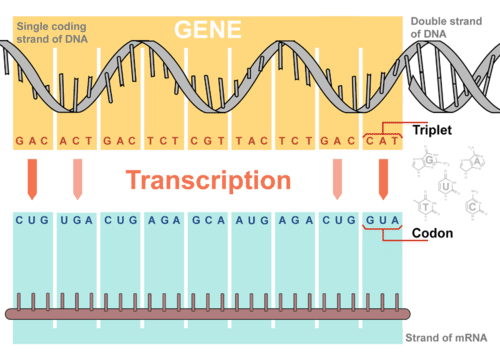What you’ll learn to do: Outline the process of transcription
Have you ever had to transcribe something? Maybe someone left a message on your voicemail, and you had to write it down on paper. Or maybe you took notes in class, then rewrote them neatly to help you review.
As these examples show, transcription is a process in which information is rewritten. Transcription is something we do in our everyday lives, and it’s also something our cells must do, in a more specialized and narrowly defined way. In biology, transcription is the process of copying out the DNA sequence of a gene in the similar alphabet of RNA.
Learning Outcomes
- Understand the basic steps in the transcription of DNA into RNA
- Understand the difference between pre-RNA and mRNA
Steps of Transcription
The process of Transcription takes place in the cytoplasm in prokaryotes and in nucleus in eukaryotes. It uses DNA as a template to make an RNA (mRNA) molecule. During transcription, a strand of mRNA is made that is complementary to a strand of DNA. Figure 1 shows how this occurs. Eventually portions of the transcribed mRNA will be made into functional proteins.

Figure 1. Overview of Transcription. Transcription uses the sequence of bases in a strand of DNA to make a complementary strand of mRNA. Triplets are groups of three successive nucleotide bases in DNA. Codons are complementary groups of bases in mRNA.

Figure 2. Transcription occurs in the three steps—initiation, elongation, and termination—all shown here.
Transcription takes place in three steps: initiation, elongation, and termination. The steps are illustrated in Figure 2.
Step 1: Initiation
Initiation is the beginning of transcription. It occurs when the enzyme RNA polymerase binds to a region of a gene called the promoter. This signals the DNA to unwind so the enzyme can ‘‘read’’ the bases in one of the DNA strands. The enzyme is now ready to make a strand of mRNA with a complementary sequence of bases.
Step 2: Elongation
Elongation is the addition of nucleotides to the mRNA strand. RNA polymerase reads the unwound DNA strand and builds the mRNA molecule, using complementary base pairs. During this process, an adenine (A) in the DNA binds to an uracil (U) in the RNA.
Step 3: Termination
Termination is the ending of transcription, and occurs when RNA polymerase crosses a stop (termination) sequence in the gene. The mRNA strand is complete, and it detaches from DNA.
Visit this BioStudio animation to see the process of prokaryotic transcription.
pre-RNA and mRNA
After transcription, eukaryotic pre-mRNAs must undergo several processing steps before they can be translated. Eukaryotic (and prokaryotic) tRNAs and rRNAs also undergo processing before they can function as components in the protein synthesis machinery.
mRNA Processing
The eukaryotic pre-mRNA undergoes extensive processing before it is ready to be translated. The additional steps involved in eukaryotic mRNA maturation create a molecule with a much longer half-life than a prokaryotic mRNA. Eukaryotic mRNAs last for several hours, whereas the typical E. coli mRNA lasts no more than five seconds.
The three most important steps of pre-mRNA processing are the addition of stabilizing and signaling factors at the 5′ and 3′ ends of the molecule, and the removal of intervening sequences that do not specify the appropriate amino acids.
5′ Capping
A cap is added to the 5′ end of the growing transcript by a phosphate linkage. This addition protects the mRNA from degradation. In addition, factors involved in protein synthesis recognize the cap to help initiate translation by ribosomes.
3′ Poly-A Tail
Once elongation is complete, an enzyme called poly-A polymerase adds a string of approximately 200 A residues, called the poly-A tail to the pre-mRNA. This modification further protects the pre-mRNA from degradation and signals the export of the cellular factors that the transcript needs to the cytoplasm.
Pre-mRNA Splicing
Eukaryotic genes are composed of exons, which correspond to protein-coding sequences (ex-on signifies that they are expressed), and intervening sequences called introns (intron denotes their intervening role), which are removed from the pre-mRNA during processing. Intron sequences in mRNA do not encode functional proteins.
All of a pre-mRNA’s introns must be completely and precisely removed before protein synthesis. If the process errs by even a single nucleotide, the reading frame of the rejoined exons would shift, and the resulting protein would be dysfunctional. The process of removing introns and reconnecting exons is called splicing (Figure 3).
Practice Question

Figure 3. Pre-mRNA splicing involves the precise removal of introns from the primary RNA transcript. The splicing process is catalyzed by protein complexes called spliceosomes that are composed of proteins and RNA molecules called snRNAs. Spliceosomes recognize sequences at the 5′ and 3′ end of the intron.
Errors in splicing are implicated in cancers and other human diseases. What kinds of mutations might lead to splicing errors?
Check Your Understanding
________ takes place in the nucleus.
- Respiration
- Translation
- Transcription
Show Answer
Transcription
Candela Citations
- Introduction to Transcription. Authored by: Shelli Carter and Lumen Learning. Provided by: Lumen Learning. License: CC BY: Attribution
- Overview of transcription. Provided by: Khan Academy. Located at: https://www.khanacademy.org/science/biology/gene-expression-central-dogma/transcription-of-dna-into-rna/a/overview-of-transcription. License: CC BY-NC-SA: Attribution-NonCommercial-ShareAlike
- Transcription of DNA to RNA. Provided by: CK-12. Located at: http://www.ck12.org/biology/Transcription-of-DNA-to-RNA/lesson/Transcription-of-DNA-to-RNA-BIO/. License: CC BY-NC: Attribution-NonCommercial
- Biology. Provided by: OpenStax CNX. Located at: http://cnx.org/contents/185cbf87-c72e-48f5-b51e-f14f21b5eabd@10.8. License: CC BY: Attribution. License Terms: Download for free at http://cnx.org/contents/185cbf87-c72e-48f5-b51e-f14f21b5eabd@10.8
- Transcription and Translation. Authored by: Bozeman Science. Located at: https://youtu.be/h3b9ArupXZg. License: All Rights Reserved. License Terms: Standard YouTube License